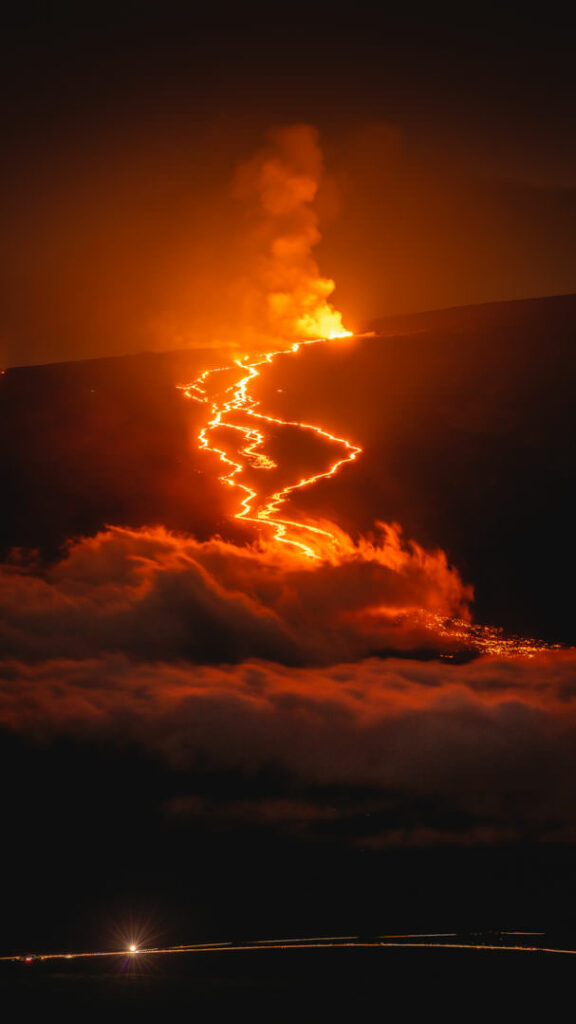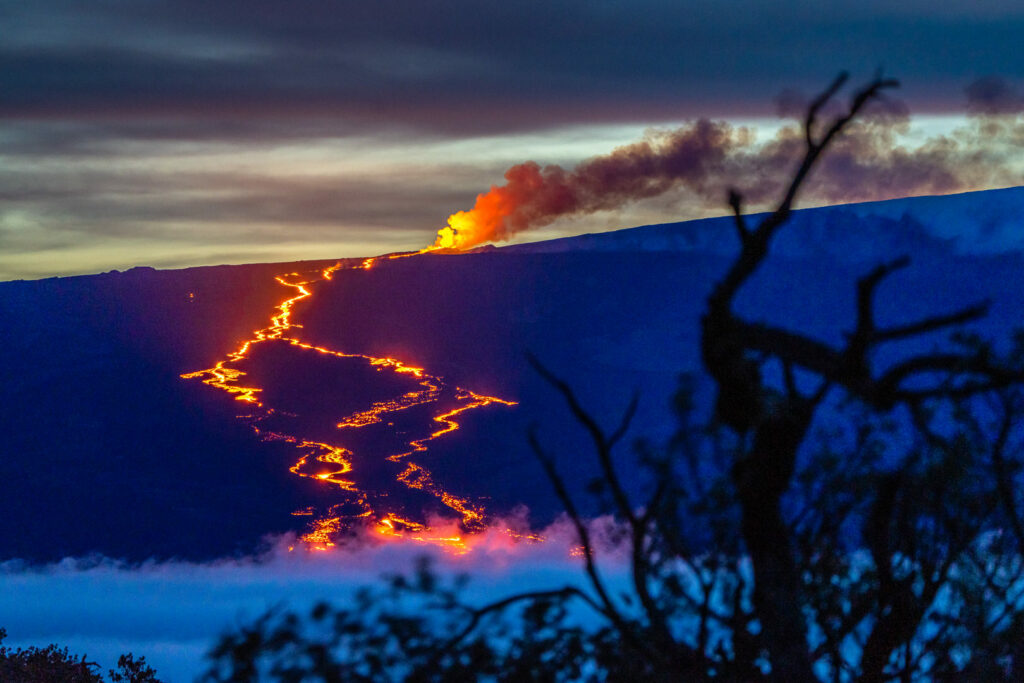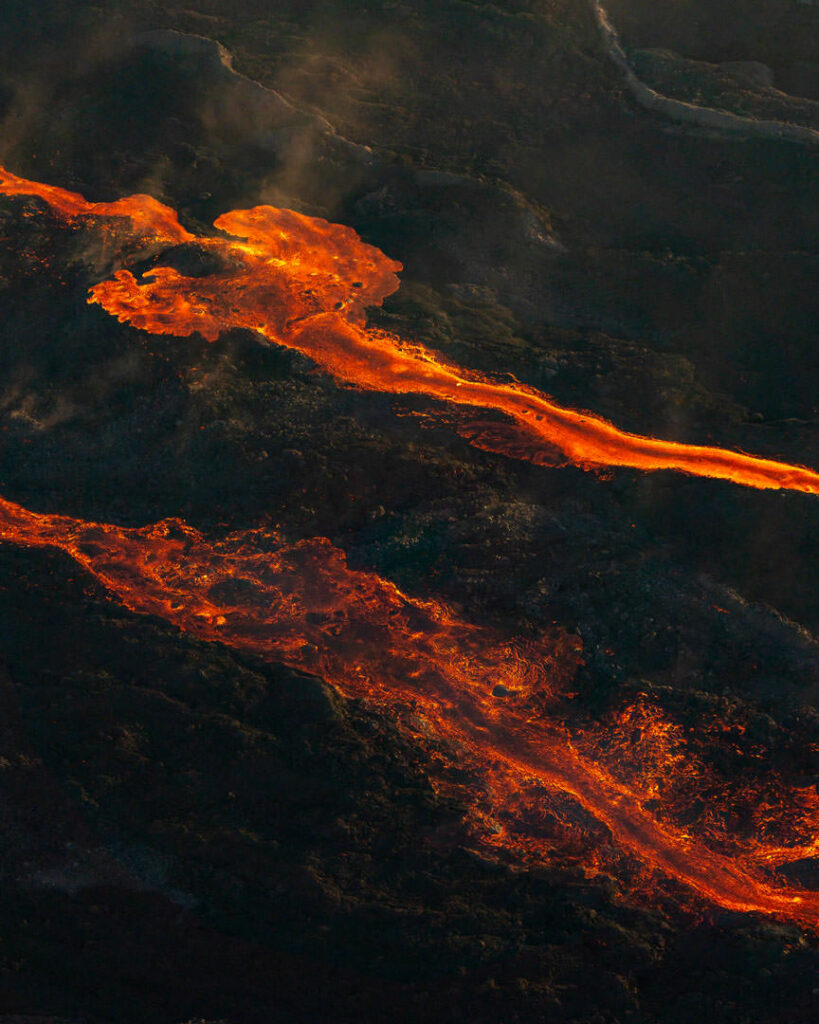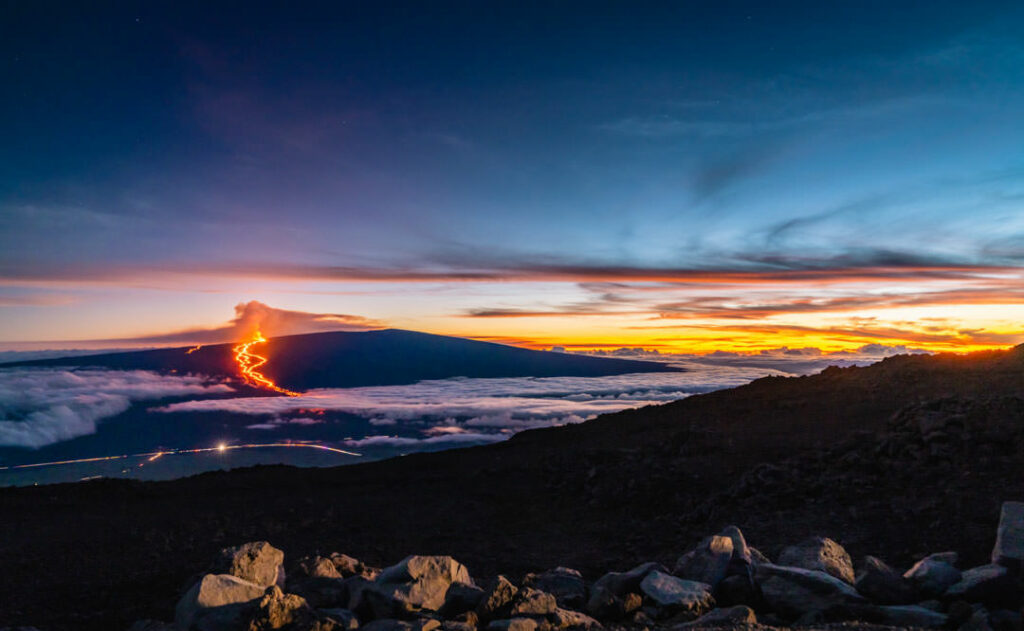
“She who shapes the sacred land.”
Pelehonuamea, or Madame Pele, invokes great respect and awe here in Hawai‘i as the goddess of fire and volcanoes.
Seen a symbol of passion, power and resilience, Pele both destroys and creates, reflecting the cyclical nature of volcanic eruptions.
To bear witness to her fiery prowess on full display in early December, when four fissures on Mauna Loa volcano erupted on Hawai‘i Island, was a true honor and incredible experience.
The strong energy and dramatic visuals were unforgettable. I’m grateful to have seen the eruption from the air twice, taking doors-off trips on Mauna Loa Helicopter Tours and Paradise Helicopters. Seeing lava in-person for the first time got me curious about this mythical madame Pele.
Her home at Kilauea Volcano remains the most active volcano in the world. But how she got there is the subject of a whole lot of different legends. We handpicked a few popular ones, knowing there are MANY other versions of these stories throughout Hawai‘i! But in case you’re wanting to learn more like we were…
The Origins of Pele

According to History Cooperative, Pele was the daughter of Haumea, an ancient goddess who was herself considered to be a descendent of the ancient earth goddess Pāpa and the supreme Sky Father Wākea. Here’s more:
“Legends claim Pele was one of six daughters and seven sons born to Haumea and was born and lived in Tahiti before she was forced to flee her homeland. The reason for this varies according to the myth. Pele was either banished by her father for her volatility and temper or fled for her life after seducing the husband of her sister Nāmaka, the sea goddess.”
Nāmaka apparently wished to put an end to not only Pele’s fires, but also Pele herself. To get to Hawai‘i, Pele traveled from Tahiti by canoe. As she moved from one island to another, it is said that Pele tried to draw lava from the ground and light fires throughout the journey. She traveled through Kaua‘i, where there is an old hill called Pu‘u kā Pele, meaning Pele’s Hill, and O‘ahu, Moloka‘i and Maui before coming to Hawai‘i Island, explains History Cooperative.
“Finally, Nāmaka caught up with Pele in Hawai‘i and the sisters battled to the death. Nāmaka emerged triumphant, putting out the fires of Pele’s wrath. After this, Pele became a spirit and went to live in the Kilauea Volcano.”
Pele, Hi‘iaka and Lohi‘au
As with pretty much all Pele legends, there are many different versions of this story about Pele’s younger sister, Hiʻiakaikapoliopele. Here’s a synopsis that brings together many common elements from University of Hawai‘i Hilo, drawing the connections between Hawaiian oral history and geology.
“Hi‘iaka came with her older sister Pele to Hawai‘i and lived there, where she protected the forests of Puna. Pele falls into a dream and meets her lover Lohi‘au on Kaua‘i. When she awakes, she asks her many sisters if one will go and retrieve Lohi‘au for her. Hi‘iaka agrees to go, but only on the condition that Pele will protect the forests in her absence. Pele agrees, but tells Hi‘iaka to return quickly. Hi‘iaka overcomes many obstacles on her journey to Kaua‘i and arrives only to find Lohi‘au dead. Hi‘iaka finds her inner powers to give life and brings him back from the dead. She and Lohi‘au then begin the long trip back. On their way, Hi‘iaka is able to sense or see that her forests are burning. Pele had become impatient, and fearing that Hi‘iaka had stolen her lover, she sent large lava flows into the forest. Upon their arrival, Hi‘iaka and Lohi‘au witness the terrible destruction and then openly displayed their love to Pele. Pele unleashes her anger at the lovers, covering Lohi‘au with lava that kills him. Hi‘iaka becomes enraged and digs up Pele’s home to find Lohi‘au. Hi‘iaka is so enraged that she tears through the layers of the earth to unleash the deep water to destroy her sister. The other Gods intervene to stop Hi‘iaka from destroying Pele. Hi‘iaka is able to bring her lover back to life and they leave together.”
Pele’s Many Forms

A tall and beautiful young woman. An old woman with a small white dog. A vanishing hitchhiker. Pele is said to disguise herself in various ways and wander among the people. It’s also widely known that those who don’t help the woman or treat her with Aloha will pay the price. In more otherworldly accounts, some see her face or profile in the lava and smoke. Others envision a women made of red flames, or surrounded by them.
Growing up here and recently experiencing the Mauna Loa eruption, I believe Pele’s power and presence are very clear, and warrant respect from all of us. These areas should be treated with great reverence. And just as a reminder…never, ever remove rocks from their homes here in Hawai“i. As explained in a University of Hawai‘i report on urban legends, “those foolish enough to take the shiny lava pieces inadvertently end up sending them back to Hawai‘i (Rohter 1980, 66). Many tales of woe are repeated in letters sent with the rocks describing family breakups, unsuccessful business ventures, car accidents and broken hearts (Kane 1987, 51-52).”
It’s also typically not recommended that you leave an offering for Pele unless you are Native Hawaiian cultural practitioner or have been trained/advised by one, according Ka‘ahele Hawai‘i.
An Awe-Inspiring Experience

These were the more mystical photos I felt aligned with the magnificent Madame Pele, so I hope you enjoy the images and appreciate the local legends! If you’d like to see more eruption photos, please check out my blog, Mauna Loa Volcano Makes its Mark. When the next eruption happens, I hope to be there again to capture such a stunning natural wonder.
